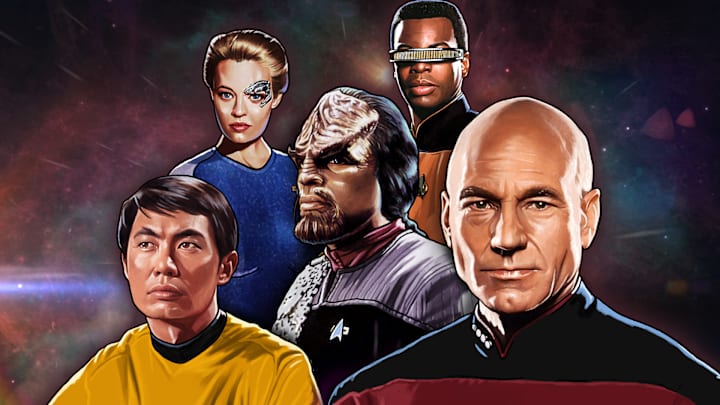5. Colored shoulders, grey undershirt (early DS9 and all of Voyager)

As the primary uniform design for the first four-and-a-half seasons of Deep Space Nine and all seven seasons of Voyager, it is reasonable to conclude that it has appeared in Star Trek more than any other uniform. It also just feels classically "Star Trek" on some level, with the colors on the shoulders being reintroduced in various subsequent uniforms, as seen in Star Trek: Picard.
Like other uniforms from the 1990s-2000s era of Star Trek, these ones were designed by Robert Blackman. They appear to technically be jumpsuits, but they are also able to "magically" transform into two-piece pants-and-jacket combos when the stories demand it. Overall, they are clean and simple uniforms, and I appreciate the prominence of the division colors.
4. The Original Series

It's one of those things where you have to give credit to the work that started all of this. Most—if not all—of the uniforms that have come since take at least a few cues from these ones, designed by William Ware Theiss. Although the two pilot episodes had slightly different designs, the uniforms for the remainder of the series established much of the design language for later Starfleet uniforms.
As with many other uniform styles, these ones are fairly simple in design and seem geared toward comfort and functionality, at least for the men's uniforms. The miniskirt-style scant variants worn by women in the show are also a famous part of Star Trek's design history. At the same time, making that design an optional variant, as seen in Strange New Worlds, seems a bit more practical.
The bright colors are also both striking and evidence of the show's production in the late 1960s when color television was a major selling point. Interestingly, the "gold" of the command uniforms was apparently more of a greenish color in real life. However, the material looked more golden under the lights and film stock, leading later iterations to use gold or yellow instead of green.
These facets of the technical processes of making television add some interest to these uniforms, even if they are visually rather plain. That, coupled with the fact that they inspired what came after, means that these uniforms deserve a place in the Top 4.
